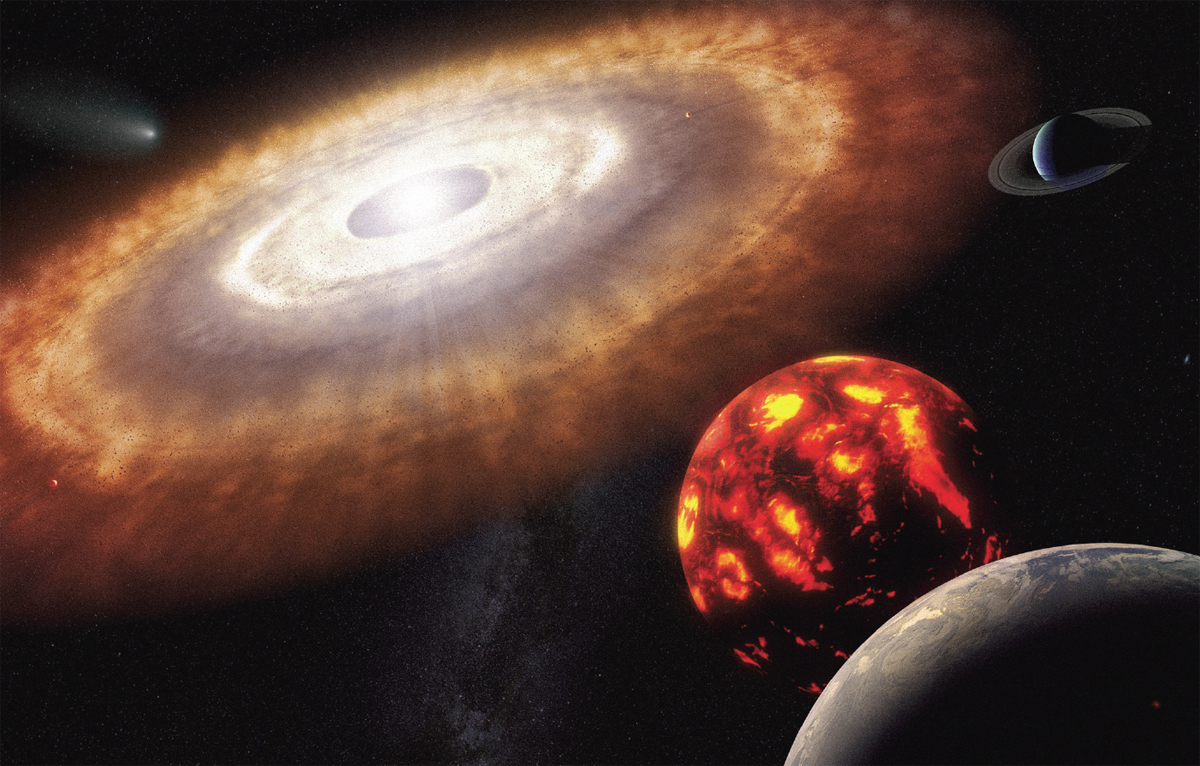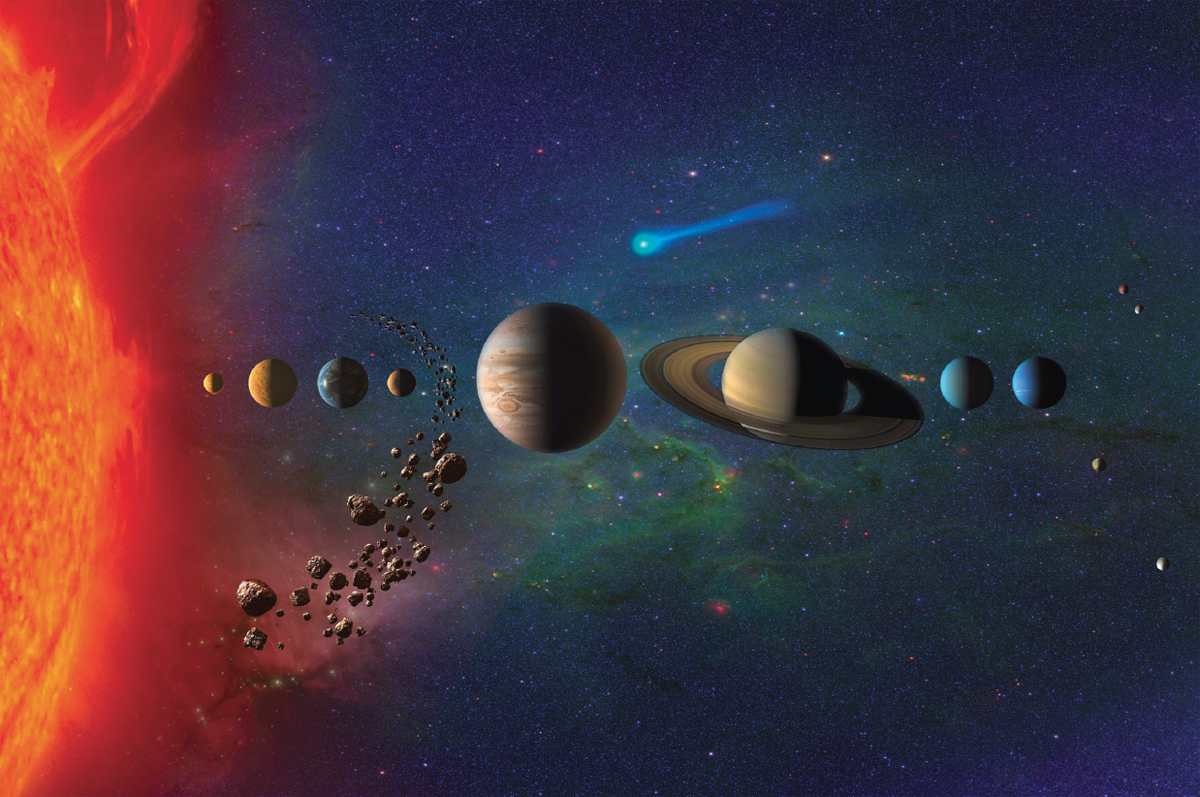
Introduction
Humans have known for millennia that some stars move with respect to their companions. Such wandering stars were considered simply lights in the night sky until some 400 years ago. Then, when Galileo Galilei and other pioneering astronomers first trained their crude telescopes on the heavens, the wanderers were revealed to have distinct surface structures, moons, and rings. Fast-forward to the 20th century, and researchers began melding theories developed by astronomers based on their observations of the Moon and planets with those developed by geoscientists from their studies here on Earth. Did the Moon’s pockmarked surface, for example, arise via the same processes that create Earth’s volcanos or impact craters? The application of terrestrial insights to extraterrestrial environments led to the creation of a new scientific discipline, planetary science.
The 19th century saw the formulation of the theories of evolution and genetics that, when combined with studies of microorganisms, suggested new approaches for addressing age-old questions concerning the origin of life. A century ago, such questions led to the hypothesis that life arose as a natural consequence of the environmental conditions early in Earth’s history. Discoveries in the second half of the 20th century—for example, the detection of isolated ecosystems sustained by chemical reactions between hot rocks and seawater associated with deep-sea vents—
strengthened such ideas. If such ecosystems could exist on Earth, were they also present in the martian subsurface or beneath the icy crusts of the satellites of the giant planets? The application of biological insights to the study of extraterrestrial environments led to a new scientific discipline, astrobiology.
The fields of planetary science and astrobiology came of age in the past few decades, when it became possible to send robotic spacecraft to the Moon and other parts of the solar system. No clearer indication of this is the fact that as of 2023, robotic spacecraft have orbited every planetary body known to Galileo. Moreover, objects unknown to Galileo—for example, the planets Uranus and Neptune and the dwarf planets Ceres and Pluto—have all been visited by spacecraft.
Studies by robotic spacecraft and telescopes are complemented by laboratory studies of meteorites and cosmic dust; field work in locations on Earth possessing some key characteristics of extraterrestrial environments; and complex computer systems programmed to analyze data or run theoretical models and simulations. Last, but by no means least, are the engineering, technical, and other support activities that enable all of these studies to take place. The sum of these contributions has transformed our understanding of the planetary bodies orbiting the Sun and other stars.
But undertaking cutting-edge activities in planetary science and astrobiology is expensive. Even the most basic spacecraft capable of addressing an important scientific question cost from $10 million to $100 million, and larger, more comprehensive missions—such as NASA’s Mars rovers, Curiosity and Perseverance—cost much more than $1 billion each. Therefore, new ventures must be carefully selected and must address the most compelling scientific questions. The final decisions as to which new activities are initiated is determined by Congress during its annual budget deliberations. But how do scientists work with federal agencies to determine the most worthwhile activities to promote?
Over the past 60 years, the U.S. space-science community, working through the National Academies of Sciences, Engineering, and Medicine, has developed an approach for identifying and prioritizing those major activities that offer the greatest promise for addressing key scientific questions in the next decade. The results of these so-called decadal surveys have proved to be highly influential in setting the scientific agenda for the next 10 years in their respective disciplines.
Decadal surveys published in 2002 and 2012, prioritized activities such as the New Horizon spacecraft, which flew past Pluto in 2015; the Europa Clipper, scheduled to depart for Jupiter and its moons in 2024; and the collection of martian samples by the rover Perseverance.
In 2020, a group of 97 leading experts was convened at the request of NASA and the National Science Foundation (NSF) to review the current state of knowledge about planetary science and astrobiology, to formulate key questions, and to outline the major initiatives necessary to find answers in the coming decade.
Three years of effort resulted in the formulation of Origins, Worlds, and Life: A Decadal Strategy for Planetary Science and Astrobiology, 2023–2032 (Washington, DC: The National Academies Press, 2023). This booklet summarizes their work and describes some of the activities needed to find the answers.
A Brief Guide to the Solar System and Beyond
Planetary bodies fall into distinct families based on factors such as composition and position in the solar system. In approximate order moving outward from the Sun (Figure 1), the main families discussed in this booklet are the following:
Terrestrial bodies: Mercury, Venus, Earth and the Moon, and Mars. All have metallic cores and rocky exteriors. Earth and Venus possess dense atmospheres, and Earth and Mercury have magnetic fields.
Asteroids and meteoroids: A diverse population of rock, metal, and carbonaceous materials, left over from the formation of the planets. Many are concentrated in a belt between Mars and Jupiter, but others are found throughout the inner solar system. Their sizes range from one-third the size of the Moon down to submillimeter grains. The smaller objects are called meteoroids. Frictional heating when a meteoroid enters an atmosphere, causes it to glow, and such objects are seen as meteors. A meteorite is a fragment of a meteoroid collected on the surface of a planetary body.

Comets: Innumerable kilometer-size bodies composed of ices and carbonaceous materials whose highly elliptical orbits periodically bring them into the inner solar system. Comets are thought to be a remnant population, scattered into the depths of space early in the history of the solar system and, following an encounter with Jupiter or one of the other giant planets, are subsequently redirected sunward where they develop their characteristic tails.
Gas giants: Jupiter and Saturn are giant planets composed almost entirely of hydrogen and helium. Both have complex atmospheric features, strong magnetic fields, intricate rings, and numerous satellites.
Galilean satellites: The four largest satellites of Jupiter. Io is slightly larger than the Moon, and Europa is slightly smaller. Callisto is as large as Mercury, and Ganymede, the largest satellite in the solar system, is bigger still. Ganymede is unique because it has a magnetic field. Three of the four are primarily made of ice with some rock, the exception being rocky Io, which displays extensive volcanic activity.
Trojans: A population of small bodies concentrated around gravitationally stable points 60 degrees ahead of and trailing Jupiter in its orbit about the Sun. These may be ice/rock remnants from the formation of Jupiter, or they may be related to Kuiper belt objects and may have been captured by Jupiter in the early solar system.
Titan and Enceladus: The largest and one of the smallest of Saturn’s major satellites. Titan is slightly smaller than Ganymede, and its dense atmosphere and hydrocarbon lakes and seas are unique. Enceladus is a geologically active ice ball only one-seventh the size of the Moon, ejecting plumes of icy particles from giant rifts near its south pole.
Ice giants: Uranus and Neptune appear to be smaller versions of the gas giants, but their internal structure and composition remain mysterious. Both are believed to have icy cores, strong magnetic fields, rings, and numerous satellites.
Triton: At three-quarters the size of the Moon, Triton is Neptune’s largest satellite and likely a captured Kuiper belt object. It is geologically active, has a very tenuous atmosphere, and has geyser-like plumes emanating from its icy surface.
Ocean worlds: The decay of radioactive materials in planetary interiors and/or tidal heating of interiors can drive geological activity. For Europa, Ganymede, Callisto, Enceladus, Titan, and Triton, such heating is sufficient to maintain oceans of liquid water beneath their icy surfaces.
Kuiper belt objects: A population of small icy bodies, of which Pluto is one of the largest known. These are remnants from the formation of the giant planets and were gravitationally scattered out of the Jupiter–Saturn–Uranus zone into trans-neptunian space early in solar system history.
Centaurs: A population of small icy bodies found on unstable orbits between Jupiter and Neptune. They are believed to be Kuiper belt objects in the process of being ejected from the trans-neptunian region into the inner solar system and, as such, may be related to comets.
Exoplanets: Many thousands of planets are known to orbit stars other than the Sun. Exoplanetary systems have diverse architectures—for example, some contain giant planets very close to their host stars, and some contain exotic objects such as bodies that appear to be composed almost entirely of water.




